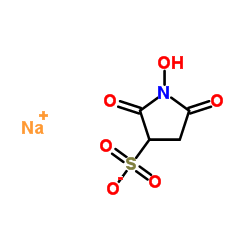N-Hydroxysulfosuccinimide sodium

N-Hydroxysulfosuccinimide sodium structure
|
Common Name | N-Hydroxysulfosuccinimide sodium | ||
|---|---|---|---|---|
| CAS Number | 106627-54-7 | Molecular Weight | 217.132 | |
| Density | N/A | Boiling Point | N/A | |
| Molecular Formula | C4H4NNaO6S | Melting Point | 250 °C (dec.)(lit.) | |
| MSDS | USA | Flash Point | N/A | |
|
The identification of a novel SIRT6 modulator from Trigonella foenum-graecum using ligand fishing with protein coated magnetic beads.
J. Chromatogr. B. Analyt. Technol. Biomed. Life Sci. 968 , 105-11, (2014) SIRT6 is a histone deacetylase that has been proposed as a potential therapeutic target for metabolic disorders and the prevention of age-associated diseases. Thus the identification of compounds that modulate SIRT6 activity could be of great therapeutic impo... |
|
|
Pd-Ir Core-Shell Nanocubes: A Type of Highly Efficient and Versatile Peroxidase Mimic.
ACS Nano 9 , 9994-10004, (2015) Peroxidase mimics with dimensions on the nanoscale have received great interest as emerging artificial enzymes for biomedicine and environmental protection. While a variety of peroxidase mimics have been actively developed recently, limited progress has been ... |
|
|
Interprotein Coupling Enhances the Electrocatalytic Efficiency of Tobacco Peroxidase Immobilized at a Graphite Electrode.
Anal. Chem. 87 , 10807-14, (2015) Covalent immobilization of enzymes at electrodes via amide bond formation is usually carried out by a two-step protocol, in which surface carboxylic groups are first activated with the corresponding cross-coupling reagents and then reacted with protein amine ... |
|
|
DNA biosensor-based on fluorescence detection of E. coli O157:H7 by Au@Ag nanorods.
Biosens. Bioelectron. 70 , 239-45, (2015) A novel DNA sensor for the detection of the Escherichia coli O157:H7 (E. coli O157:H7) eaeA gene was constructed using surface enhanced fluorescence (SEF). The spacing distance dependence nature of Au@Ag nanorods surface enhanced fluorescence was investigated... |
|
|
Aptamer-conjugated gold nanorod for photothermal ablation of epidermal growth factor receptor-overexpressed epithelial cancer.
J. Biomed. Opt. 19(5) , 051203, (2013) Biomarker-specific photothermal nanoparticles that can efficiently sense markers that are overexpressed in distinguished adenocarcinomas have attracted much interest in an aspect of efficacy increase of cancer treatment. We demonstrated a promising prospect o... |
|
|
Plasma biomarker discovery in preeclampsia using a novel differential isolation technology for circulating extracellular vesicles.
Am. J. Obstet. Gynecol. 211(4) , 380.e1-13, (2014) To circumvent the complex protein milieu of plasma and discover robust predictive biomarkers for preeclampsia (PE), we investigate if phospholipid-binding ligands can reduce the milieu complexity by extracting plasma extracellular vesicles for biomarker disco... |
|
|
Simultaneous detection of multi-allergens in an incurred food matrix using ELISA, multiplex flow cytometry and liquid chromatography mass spectrometry (LC-MS).
Food Chem. 175 , 585-92, (2015) Food allergy is a public health concern and an important food safety issue. Food allergies affect up to 6% of infants and children and 4% of adults. The objective of this work was to determine differences in the detection of single and multiple allergens (i.e... |
|
|
Magnetic beads-based electrochemical immunosensor for monitoring allergenic food proteins.
Anal. Biochem. 484 , 4-8, (2015) Screen-printed platinum electrodes as transducer and magnetic beads as solid phase were combined to develop a particle-based electrochemical immunosensor for monitoring the serious food allergen ovalbumin. The standard arrangement of enzyme-linked immunosorbe... |
|
|
Water-soluble nanoconjugates of quantum dot-chitosan-antibody for in vitro detection of cancer cells based on "enzyme-free" fluoroimmunoassay.
Mater. Sci. Eng. C. Mater. Biol. Appl. 52 , 61-71, (2015) Cancer remains one of the world's most devastating diseases with millions of fatalities and new cases every year. In this work, we attempted to develop a facile "enzyme-free" fluoroimmunoassay based on the novel nanoconjugates composed of CdS quantum dots (QD... |
|
|
Probing the size limit for nanomedicine penetration into Burkholderia multivorans and Pseudomonas aeruginosa biofilms.
J. Control. Release 195 , 21-8, (2014) Encapsulation of antibiotics into nanoparticles is a potential strategy to eradicate biofilms. To allow further optimization of nanomedicines for biofilm eradication, the influence of the nanoparticle size on the penetration into dense biofilm clusters needs ... |